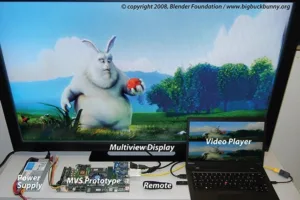Disney Research is working with ETH Zurich, to build a system that can convert existing stereoscopic 3D content into multiview (autostereoscopic) content in real time.
A combination of computer algorithms and hardware is used in the system, which allows stereo 3D content to be played in new ‘glasses-free’ displays, aka multiview autostereoscopic displays (MADs). The hardware could potentially be integrated into an SoC.
MADs work by showing several views of the same piece of content, which is ‘stitched’ into a 3D image by the human brain. To convert stereo 3D content, which uses just two views, into this format, the Disney/ETH team used an approach based on image domain warping (IDW).
IDW dispenses with depth maps. Instead, the left and right input images are analysed to reveal features such as saliency information, point correspondence and edges. An algorithm solves any optimisation problem and ‘image warps’ are calculated; these transform the input images to new viewing positions between the two original views.
The researchers were able to use this method to synthesise eight new views, in real time and Full HD resolution.
Although the IDW method is computationally intensive, the hardware design used is said to be efficient enough to enable fully automatic synthesis.

